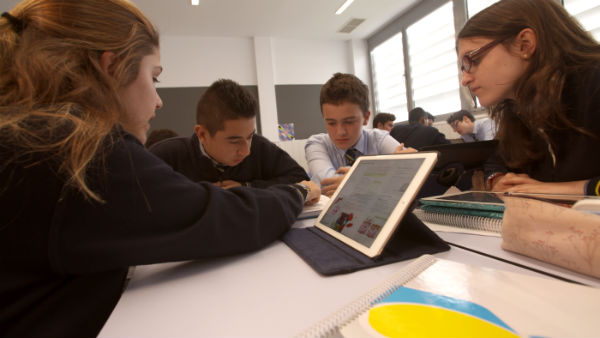This methodology is not one of the most recent, but the fact of being able to see the dynamics in situ and having the explanations of Jose Luis Marrero, ESO and Baccalaureate Director and ICT Coordinator of the center, made me think that it could be interesting to investigate and share its main features in #Realinfluencers.
What is cooperative learning?
Cooperative learning is a methodology that emerged at the beginning of the 1990s from the likes of Johnson & Johnson, Kegan, although the American philosopher John Dewey was his first inspiration at the beginning of the 20th century.
The main characteristic is that it is structured based on the formation of groups of 3-6 people, where each member has a specific role and to reach the objectives it is necessary to interact and work in a coordinated manner.
In cooperative learning, the final objective is always common and will be achieved if each of the members successfully performs their tasks. On the other hand, in the Individual Learning the student focuses on achieving their objectives without having to depend on the rest of their classmates.
The definition of the role of each student and the structure of the group can be established both by the teachers and by the students themselves. According to some studies, when the teachers are the ones define the roles and the learning objectives, it is called Cooperative Learning and when the students are the ones taking on that responsability it is called Collaborative.
In cooperative learning, heterogeneous groups of students work together in a coordinated manner to solve academic tasks and deepen their own learning and the objectives of the participants are closely linked
What are the advantages of Cooperative Learning?
Coordination: The team needs all the members to learn and be able to transmit to the rest of their colleagues the necessary knowledge to solve the problem.
Interaction: Not only is the learning of the subjects enhanced, it is also necessary to use social skills to request information, define processes, negotiate priorities … and the performance of roles: leader, organizer, facilitator, consensus seeker or the constant.
Practical application: they need not only to understand the theory of the problem but also to know how to put it into practice in “real” situations, which leads the student to a deep understanding of the subject.
Social skills, practical application of theory, support among students and sense of responsibility are some of the benefits of this model
Support: improves the skills of those students who are more delayed with respect to the group, since they will have the constant support of the rest of their classmates. If the group is well balanced there will always be a partner willing to explain and guide the students with more difficulties.
Responsibility: students are responsible not only for completing their tasks to achieve the objective, but also for supporting other classmates.
The role of the teacher in Cooperative Learning
The teacher must establish the following parameters so that the methodology works correctly:
Create groups of between 3 and 6 people based on heterogeneity and positive interdependence, where everyone complements and takes responsibility for their work and that of others.
Specify the objectives of both the project and the learning before starting the dynamic and make clear what are the criteria for success.
Organize the space so that it favors the interaction between the students and the access to the necessary resources to carry out the project.
Provide guidance on the steps to follow to achieve the objective, the work process or the role of each of the team members.
The teacher creates the groups, establishes objectives, guides on how to achieve them and finally must adequately evaluate the group system
Advise the groups during the work process and help them in the search of solutions before the possible inconveniences that are going to be found.
Finally, and given that the dynamics wants to promote group work, it is also key that the evaluation has the same character, both individual and group.
Warnings about Cooperative learning
It is not an easy model to implement, it implies many changes with respect to conventional dynamics.
Establish levels of success: there will be students who are not active and do not adapt to teamwork, letting themselves be carried by the cadence of the group without contributing.
Do you have experience as a teacher in Cooperative Learning? Leave your comment.
REFERENCIAS
http://www.educarueca.org/IMG/pdf/Aprendizaje_cooperativo.pdf
http://fernandotrujillo.es/wp-content/uploads/2010/05/AC_libro.pdf
http://grupsderecerca.uab.cat/grai/es/content/m%C3%A9todos-de-aprendizaje-cooperativo
http://www.studygs.net/espanol/cooplearn.htm
http://www.madrid.org/dat_capital/upe/impresos_pdf/AprendizajeCooperativo2012.pdf
Foto: archivo BlinkLearning, todos los derechos reservados


